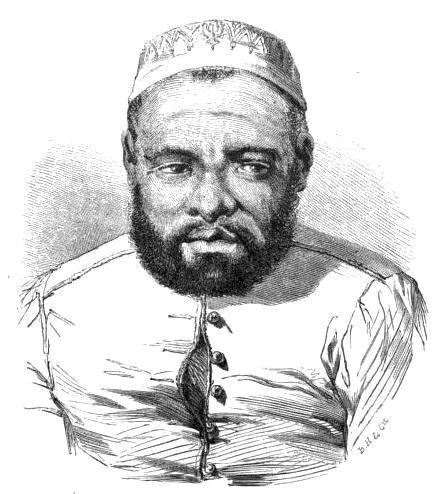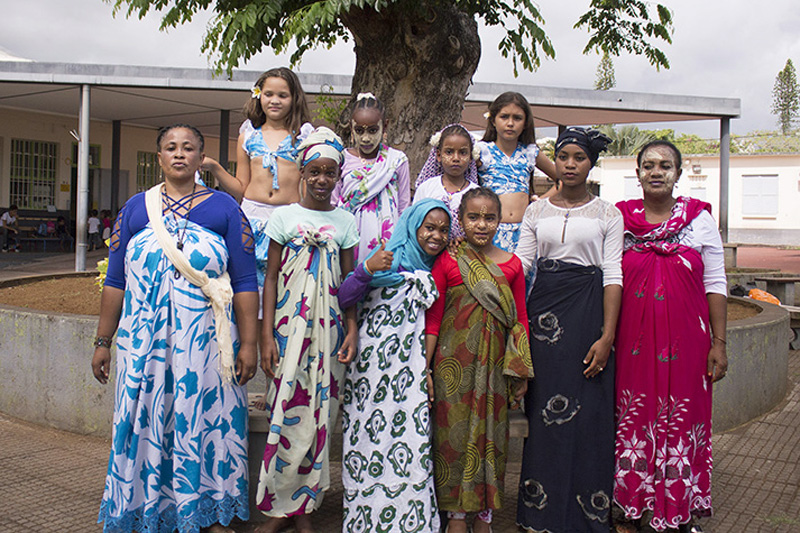|
Masonjoany
Masonjoany () (or msindanu or msindzano in Comoros and Mayotte) is a cosmetic paste and sunscreen made of ground wood. It is worn as a protective and decorative mask by women and girls in Madagascar, Comoros, and Mayotte. In Madagascar, the paste has yellow and white forms, with yellow masonjoany being derived from the wood of the tabàky or Madagascar sandalwood ('' Coptosperma madagascarensis''), and white masonjoany deriving from the wood of the aviavy or fihamy tree (''Ficus grevei''). In Comoros, the most commonly used tree for msindzano is Indian sandalwood (''Santalum album''), producing a "canary yellow" paste. The wood is ground against a surface of ceramic, stone, or coral skeleton, and combined with water and oil to make the paste. The practice in Madagascar originates from cultural exchange in Nosy Be between Malagasy natives and Indian merchants, who first arrived to the island in the 11th century CE. Masonjoany is both protective and decorative: women wear it as ... [...More Info...] [...Related Items...] OR: [Wikipedia] [Google] [Baidu] |
Culture Of Madagascar
The culture of Madagascar reflects the origins of the Malagasy people in Southeast Asia, East Africa and Oceania. The influence of Arabs, Indians, British, French and Chinese settlers is also evident. The most emblematic musical instrument of Madagascar, the ''valiha'', is a bamboo tube zither carried to the island by early settlers from South Kalimantan, southern Borneo, and is very similar in form to those found in Music of Indonesia, Indonesia and the Music of the Philippines, Philippines today. Traditional Architecture of Madagascar, houses in Madagascar are likewise similar to those of southern Borneo in terms of symbolism and construction, featuring a rectangular layout with a peaked roof and central support pillar. Reflecting a widespread veneration of the ancestors, tombs are culturally significant in many regions and tend to be built of more durable material, typically stone, and display more elaborate decoration than the houses of the living.Acquier (1997), pp. 143 ... [...More Info...] [...Related Items...] OR: [Wikipedia] [Google] [Baidu] |
Sunscreen
Sunscreen, also known as sunblock, sun lotion or sun cream, is a photoprotection, photoprotective topical product for the Human skin, skin that helps protect against sunburn and prevent skin cancer. Sunscreens come as lotions, sprays, gels, foams (such as an expanded foam lotion or whipped lotion), sticks, powders and other topical products. Sunscreens are common supplements to clothing, particularly sunglasses, sunhats and special sun protective clothing, and other forms of photoprotection (such as umbrellas). Sunscreens may be classified according to the type of #Active_ingredients, active ingredient(s) present in the formulation (inorganic compounds or organic compound, organic molecules) as: * Mineral sunscreens (also referred to as physical), which use only inorganic compounds (zinc oxide and/or titanium dioxide) as active ingredients. These ingredients primarily work by absorbing UV rays but also through reflection and refraction. * Chemical sunscreens, which use organic ... [...More Info...] [...Related Items...] OR: [Wikipedia] [Google] [Baidu] |
Vezo
The Vezo is a Sakalava Malagasy term for ''Bajo'', the semi-nomadic maritime or sea people from Central–Eastern Indonesia (esp. Flores Sea) who settled in southern Madagascar. They speak a variety of Malagasy language, Malagasy dialect continuum, part of the larger Austronesian languages, Austronesian. They currently populate most of the littoral zone along Madagascar's west coast between Toliara and Mahajanga. "Vezo" literally means 'the people who fish', but also has been known to mean 'to struggle with the sea'.Kaufmann Ethnic identity Vezo do not identify with a particular ethnic groups of Madagascar, Malagasy ethnic group but instead with their way of life.Rita Astuti They currently populate most of the littoral zone along Madagascar's west coast between Toliara and Mahajanga. Like most other Malagasy ethnic groups, their origins can directly be traced to that original mix of Austronesian settlers from Asia and the Bantu migrants from mainland East Africa with Arab-Persian ... [...More Info...] [...Related Items...] OR: [Wikipedia] [Google] [Baidu] |
Sakalava
The Sakalava are an ethnic group of Madagascar. They are primarily found on the western edge of Madagascar from Toliara in the south to the Sambirano River in the north. The Sakalava constitute about 6.2 percent of the total population, or about 2,079,000 in 2018. Their name means "people of the long valleys." Ethnic identity The Sakalava are a number of smaller ethnic groups that once comprised an empire, rather than an ethnic group in its own right. The origin of the word ''Sakalava'' itself is still subject to controversy, as well as its actual meaning. The most common explanation is the modern Malagasy translation of Sakalava meaning long ravines, denoting the relatively flat nature of the land in western Madagascar. Another theory is that the word is possibly from the Arabic '' saqaliba'', which is in turn derived from Late Latin ''sclavus'', meaning slave. History Sakalavas are considered to be a mix of Austronesian and Bantu peoples. Austronesian peoples from variou ... [...More Info...] [...Related Items...] OR: [Wikipedia] [Google] [Baidu] |
Skin Whitening
Skin whitening, also known as skin lightening and skin bleaching, is the practice of using chemical substances in an attempt to lighten the skin or provide an even skin color by reducing the melanin concentration in the skin. Several chemicals have been shown to be effective in skin whitening, while some have proven to be toxic or have questionable safety profiles. This includes mercury compounds which may cause neurological problems and kidney problems. In a number of African countries, between 25% and 80% of women regularly use skin whitening products. In Asia, this number is around 40%. In India, specifically, over half of the skin care products are sold to whiten skin. In Pakistan, where skin lightening products are popular, creams have been found to contain toxic levels of hydroquinone and mercury. Efforts to lighten the skin date back to at least the 16th century in Asia. While a number of agents — such as kojic acid and alpha hydroxy acid — are allowed in cosme ... [...More Info...] [...Related Items...] OR: [Wikipedia] [Google] [Baidu] |
Culture Of Mayotte
The culture of Mayotte is characterized by the diversity of the cultural practices of its inhabitants (256,518, 2017 estimate). Mayotte's culture is the result of crossings of populations for centuries,https://www.culture.gouv.fr/content/download/195793/file/MusiquesdeMayotte.pdf?inLanguage=fre-FR it is the result of a very rich mixture. This mixture is reflected in the music, song and dance. The island has a great musical and choreographic tradition linked to Arab-Muslim culture. The Mahorese culture is also close to the Sakalava culture (North West of Madagascar). Kibushi, a language of Malagasy origin, is the mother tongue of approximately 30% of the population, Mayotte thus representing the most western territory of the Austronesian linguistic and cultural area. Recent archaeological work has demonstrated the historical presence of these traditions from the ninth century, and again in the twelfth century in the graves (Accoua and civilization of Dembeni), or in everyday ... [...More Info...] [...Related Items...] OR: [Wikipedia] [Google] [Baidu] |
Central Highlands (Madagascar)
The Central Highlands, Central High Plateau, or Hauts-Plateaux are a mountainous biogeographical region in central Madagascar. They include the contiguous part of the island's interior above 800 m (2,600 ft) elevation. The Central Highlands are separated from the Northern Highlands of the northern tip of Madagascar by a low-lying valley, the Mandritsara Window, which has apparently acted as a barrier to dispersal for species in the highlands, leading to species pairs such as ''Voalavo gymnocaudus'' and '' Voalavo antsahabensis'' in the Northern and Central Highlands. Species restricted to the Central Highlands include the bats '' Miniopterus manavi'' and '' Miniopterus sororculus''; the rodents '' Brachyuromys betsileoensis'' and ''Voalavo antsahabensis''; the tenrecs '' Hemicentetes nigriceps'' and '' Oryzorictes tetradactylus''; and the lemur '' Cheirogaleus sibreei''. Because of the continuous habitat of the Central Highlands, there is little local endemism, unlike t ... [...More Info...] [...Related Items...] OR: [Wikipedia] [Google] [Baidu] |
Toliara
Toliara (also known as ''Toliary'', ; formerly ''Tuléar'') is a city in southern Madagascar. It is the capital of the Atsimo-Andrefana region, located 936 km southwest of the national capital Antananarivo. The current spelling of the name was adopted in the 1970s, reflecting the orthography of the Malagasy language. Many geographic place names, assigned French spellings during the colonial period, were altered following Malagasy independence in 1960. The city has a population of 168,758 in 2018. As a port town it acts as a major import/export hub for commodities such as sisal, soap, hemp, cotton, rice and peanuts. History In the 17th century, French buccaneers landed in the bay of St. Augustine near the Tropic of Capricorn, and founded the city to maintain commercial relations. It was not until the colonial period, after 1897, when the city really grew: with the efforts of Joseph Gallieni to install French administrative services, previously isolated on the island of N ... [...More Info...] [...Related Items...] OR: [Wikipedia] [Google] [Baidu] |
Antsiranana Province
Antsiranana is a former province of Madagascar with an area of 43,406 km2. It had a population of 1,188,425 (July 2001). Its capital was Antsiranana. A diversity of ethnic groups are found in the province, including Anjoaty, Sakalava, Antakarana, Tsimihety, Antemoro, Betsimisaraka, Antandroy, etc. History A major battle took place at Diego-Suárez (now Antsiranana), the largest city in Antsiranana Province, in May 1942. "Fierce fighting" in the area saw over 500 Allied casualties. On May 29, Japanese submarine I-10 surfaced off the coast and launched a Nakajima A6M2-N reconnaissance aircraft over the port. Operation Ironclad was relaunched, after being stalled, on June 22 to counterattack, with supporting forces from the East African Brigade Group and later the Rhodesian 27th Infantry Brigade in July. Geography Antsiranana Province bordered Toamasina Province to the southeast and Mahajanga Province to the southwest. The province has been described as being "virtually is ... [...More Info...] [...Related Items...] OR: [Wikipedia] [Google] [Baidu] |
Regions Of Madagascar
Madagascar is divided into 23 region, regions (''faritra''). These formerly second-tier administrative divisions became first-level administrative divisions when the former six Provinces of Madagascar, provinces were dissolved on 4 October 2009. Elections The last elections for the regional councils were held on 16 March 2008. See also * Subdivisions of Madagascar * Districts of Madagascar *List of regions of Madagascar by Human Development Index * List of cities in Madagascar References Sources * Population, area: ''Madagascar: Profil des marchés pour les évaluations d’urgence de la sécurité alimentaire'* (in French:Découpage Territorial - L'Express.mg Regions of Madagascar, Subdivisions of Madagascar Lists of administrative divisions, Madagascar, Regions Administrative divisions in Africa, Madagascar 2 First-level administrative divisions by country, Regions, Madagascar Madagascar geography-related lists {{Madagascar-geo-stub ... [...More Info...] [...Related Items...] OR: [Wikipedia] [Google] [Baidu] |








